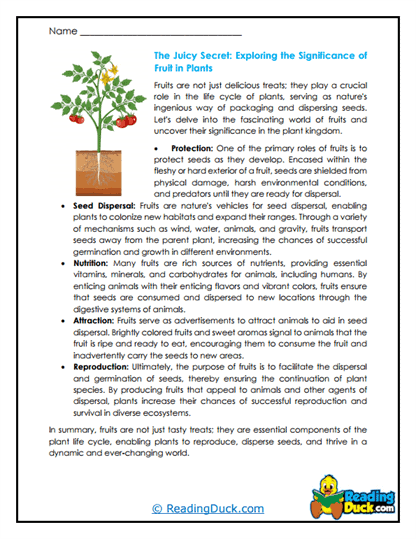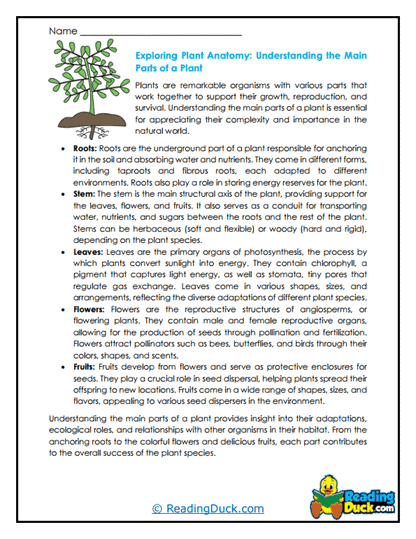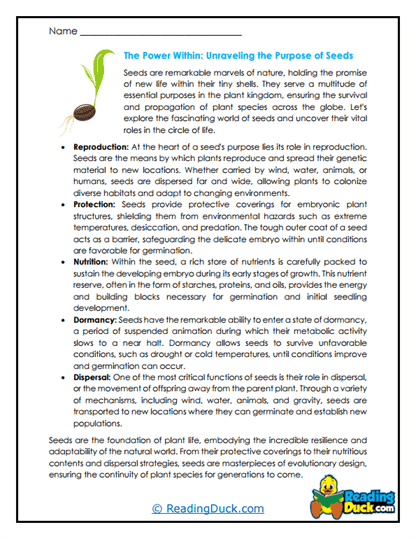Parts Of Plants Worksheets
About Our Parts of Plants Worksheets
Our collection of Parts of Plants worksheets offers an engaging way for students to explore and understand the different components of plants and their functions. This collection, a subtopic under Biology and Plants, is designed to help students grasp the essential roles that various plant parts play in the life cycle and survival of plants.
Each worksheet set includes:
- Multiple Choice Questions: These questions assess students' understanding of the reading passage by asking them to choose the correct answer from several options. This format reinforces key facts and concepts about plant parts and their functions.
- Short Answer Questions: In this section, students are required to write their own answers to questions based on the reading passage. This approach encourages them to articulate their understanding in their own words, enhancing their comprehension and retention.
- Open-Ended Questions: These questions prompt students to express their personal input, opinions, or reflections related to the reading material. This format allows students to connect the topic of plant parts to their own experiences and broader understanding of nature.
Answer keys are provided for all question sheets, making it easy for teachers and parents to review and assess students' work. All worksheets are available as PDF files, which can be conveniently viewed electronically, downloaded, and printed for classroom or homeschool use.
Understanding Plant Parts: Exploring the Anatomy of Plants
Plants are incredibly diverse organisms that play a crucial role in sustaining life on Earth. To understand how plants grow, reproduce, and survive, it is essential to learn about their different parts and the specific functions each one serves. When teaching students about plant parts, it's important to present each part systematically, explaining how they work together to help the plant thrive.
What Are the Main Parts of a Plant?
Plants have several key parts, each with distinct roles that contribute to the plant's overall health and survival. These parts include roots, stems, leaves, flowers, fruits, and seeds. Understanding these components helps students appreciate how plants function as living organisms.
- Roots:
- Description: Roots are the part of the plant that typically grows underground. They anchor the plant in the soil and absorb water and nutrients necessary for growth.
- Functions:
- Anchorage: Roots keep the plant stable in the ground, preventing it from being uprooted by wind or water.
- Absorption: Roots take in water and essential minerals from the soil, which are then transported to other parts of the plant.
- Storage: Some plants store food and nutrients in their roots, such as in carrots and beets, which are actually the plant's taproots.
- Stems:
- Description: Stems are the plant's support structure, typically growing above ground. They hold the plant upright and serve as conduits for transporting water, nutrients, and food between the roots and leaves.
- Functions:
- Support: Stems hold up the leaves, flowers, and fruits, positioning them to maximize light absorption and pollination.
- Transport: The stem contains vascular tissues—xylem and phloem—that transport water, minerals, and sugars throughout the plant.
- Growth: Stems can also produce new leaves, branches, and flowers, allowing the plant to grow and reproduce.
- Leaves:
- Description: Leaves are the primary sites of photosynthesis in most plants. They come in various shapes and sizes, depending on the species and environmental conditions.
- Functions:
- Photosynthesis: Leaves capture sunlight and convert it into chemical energy through photosynthesis, producing food (glucose) for the plant.
- Gas Exchange: Leaves have tiny openings called stomata that allow for the exchange of gases (carbon dioxide in, oxygen out) necessary for photosynthesis.
- Transpiration: Leaves also help regulate water balance in the plant through transpiration, where water evaporates from the leaf surface.
- Flowers:
- Description: Flowers are the reproductive structures of many plants. They are often colorful and fragrant, attracting pollinators like bees, birds, and insects.
- Functions:
- Reproduction: Flowers produce seeds through the process of pollination and fertilization. The male part (stamen) produces pollen, while the female part (pistil) contains the ovary where seeds develop.
- Attraction of Pollinators: The color, shape, and scent of flowers are designed to attract pollinators, which help transfer pollen from one flower to another, facilitating reproduction.
- Fruits:
- Description: Fruits develop from the fertilized ovary of a flower and contain seeds. They protect the seeds and aid in their dispersal.
- Functions:
- Seed Protection: Fruits encase the seeds, protecting them from damage and predators.
- Seed Dispersal: Fruits often help in spreading seeds away from the parent plant. Some fruits are eaten by animals, which then excrete the seeds elsewhere, while others might be carried by wind or water.
- Seeds:
- Description: Seeds are the result of fertilization in flowers and contain the embryo of a new plant. They are the starting point for the next generation of plants.
- Functions:
- Germination: When conditions are right, seeds germinate and grow into new plants, ensuring the continuation of the species.
- Dispersal: Seeds are often equipped with structures that help them disperse to new locations, reducing competition with the parent plant.
How Do Plant Parts Work Together?
Plants are complex organisms, and their parts work in harmony to ensure their survival and reproduction. Here’s how these parts interact:
- Water and Nutrient Uptake:
- Roots absorb water and nutrients from the soil. These are then transported up through the stem to the leaves, where they are used in photosynthesis to produce food for the plant.
- Energy Production:
- Leaves capture sunlight and convert it into chemical energy through photosynthesis. This energy is then transported through the plant’s vascular system to support growth and reproduction.
- Reproduction:
- Flowers attract pollinators, which helps in the fertilization process, leading to the production of fruits and seeds. These seeds then disperse, allowing new plants to grow and continue the life cycle.
Using These Worksheets Effectively
Teachers and parents can use these Parts of Plants worksheets in various creative and effective ways to enhance students' learning experiences:
- Plant Dissection Activity: After learning about the different parts of plants, students can engage in a hands-on activity where they dissect a flower or a simple plant. This exercise allows them to observe the structures they’ve studied and understand their functions in a real-world context.
- Create a Plant Parts Chart: Encourage students to create a detailed chart or poster that illustrates the different parts of a plant and their functions. This visual aid can be a valuable tool for reinforcing their understanding and can be displayed in the classroom as a reference.
- Plant Growth Experiment: Students can plant seeds and monitor their growth over time, recording observations about how different parts of the plant develop. This ongoing experiment provides practical insight into the life cycle of plants and the role of each part in their growth.
- Plant Part Scavenger Hunt: Organize an outdoor scavenger hunt where students search for different plant parts, such as roots, stems, leaves, and flowers. This activity encourages exploration and helps students connect what they’ve learned with real plants in their environment.
The Critical Role of Plant Parts in Our World
Understanding the different parts of plants is fundamental to grasping how these organisms sustain life on Earth. Plants are not just passive organisms; they are dynamic systems where each part plays a vital role in the plant’s survival, growth, and reproduction. Roots, stems, leaves, flowers, fruits, and seeds all work together in a complex yet harmonious way, enabling plants to thrive in diverse environments. Moreover, these plant parts are crucial for ecosystems and human life, providing food, oxygen, medicine, and more. By learning about the parts of plants, students gain a deeper appreciation for the intricate and essential roles plants play in our world, underscoring the importance of preserving plant life for future generations.









